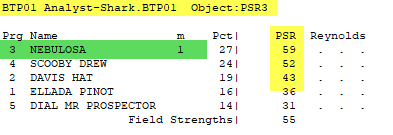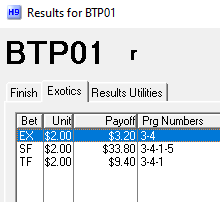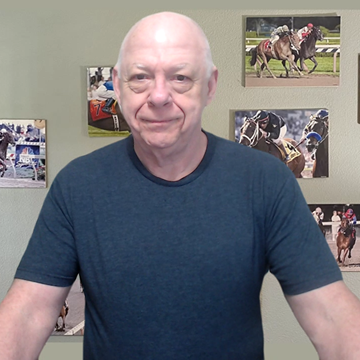-
Ranch is doing okay!Lasix has me in shape. I had a race with Bolt scheduled, but he found out I cheated on the lane assignments and he backed out. Gutless. — RanchWest
Well, I see that your terrible sense of humor is still in place. LOL -
Ranch is doing okay!
That's wonderful!
When will you be ready to race again?
Will you need a workout or two first or is it straight back to the track? -
Anything Better than APV or EPS for a Class Rating?Ah, that dumbass Biniak. He's the dullest tool in the shed. — Biniak
Yes, we took a secret poll and that's what we all agreed. LOL
(Couldn't find a roll eyes emoji in there.) -
Concepts & POV - Part 3I'm going to try to explain using simple statements without a lot of explanation.
_______________________
When you handicap, your handicapping is based upon a strategy.
The typical strategy of old was:
- Pick Contenders
- Make a line - which is really "make probabilities."
- Bet the overlays.
- This doesn't work any more because the odds change drastically after we've made our bets.
- To make matters worse, this is what the whales do, so if we do this, we're doomed.
I believe the answer is to see different scenarios.
Bye "scenario" I mean a situation.
The following are examples of scenarios.
- One horse in the 1st Tier.
- Two horses in the 1st tier.
- Three plus horses in the 1st tier.
- Odds
- Early Speed
- Contenders
Let's turn those into questions.
- "How many horses are likely to battle for the lead at the 1st call?"
- "How many horses are likely to be well-bet?"
- "How many horses are really contenders?"
So, what I am saying is that those 3 questions, each with 3 possible answers produce 9 different scenarios. (i.e. branches)
Each branch MAY demand a different approach to be successful.
___________________________________________________
LESSON 6: SUCCESSFUL PLAYERS NEED TO HAVE DIFFERENT STRATEGIES TO ADDRESS DIFFERENT SCENARIOS.
___________________________________________________ -
Anything Better than APV or EPS for a Class Rating?Also, generally speaking, the longer the distance, the slower the speed. So, you have to compare to some standard for the distance. And, those standards, pars, can vary by track. — RanchWest
When I say, PARS I am referring to the track par - how fast the track is - as opposed to what's the par for this race? -
Winning is About Concepts and POVI don't think I understand how you are defining "leverage point". Could you clarify that, please? — RanchWest
From today's post (which will be finished in a few hours).
WHAT ARE THE LEVERAGE POINTS?
Now that we have our win bet, what other plays might we make?
________________________
A Leverage Point is based upon this question:
"How do I EXPLOIT what I believe to be true?"
Think of it like this.
You've determined what your Win Bet(s) are.
In what other bets can you take advantage of what you know that the public likely doesn't?
________________________
To be clear, LEVERAGE POINTS are not a one-size-fits-all thing, but there will be some standard SCENARIOS that will arise.
I cannot tell you what YOUR leverage points are because your approach to the game is different than mine.
________________________
KEY POINT:
As you are building your processes, each step in the process ANSWERS A KEY QUESTION!
Examples:
- Who are the likely low-odds horses?
(What I call "1st Tier.") - Is there a Bet-Against-Low-Odds horse? (BALO)
- Who are the likely Early Speed horses based upon Running Style?
- Do the Early Speed Running Styles indicate that the race will have a predictable pace?
- Are there likely Early Speed RS horses that fit the model?
- Which horses figure to qualify on pure ability?
Each of these answers change how the race should be handicapped and bet!
This will take some individual thinking - and possibly some discussion with someone who is getting it, or at least above your current level in getting it.
________________________
I started this thread because strong players do this sort of thing. Maybe not formally, but they SEE THE RACES FROM A DIFFERENT POV. - Who are the likely low-odds horses?
-
Winning is About Concepts and POV
Love hearing this.
So much so that I'm going to share the most important piece to the puzzle right now.
LEVERAGE POINTS
This is almost the last step in the process. It comes just before you make your bets in the race.
At this point your handicapping is finished. You've decided who the horses are to be bet.
I'm going to go through a few examples from Aug 3. These are consecutive races, and we'll just see what comes up. I'm only going to say a little about HOW I got to this point because that's for another topic.
BTP01

This race I have #3, who projects to be about 1/2.
He is a single for me. Before you check out of this thread and say, "Oh, all he does is bet favorites," remember this is about how I figure out my leverage points after I've chosen my contenders & win bet(s).
In this first case, I will show you some obvious things.

Above is the Artificial Morning Line Object - aML. Of the 6 factors used to predict the odds, this guy has five 1sts and one 2nd. He is simply much the best.

In terms of Early Running Style (ESx), he is not only ranked #1 but figures to dominate.

In terms of the pace model, the E Running style is the most powerful by far, with a 151 to 45 index value. IOW, the model is all early.
The 3 factors chosen to best fit the model are:
F1 - Avg of Last 2
EP - Best Ever
EP - Best 2 Ever
Based upon the percents, she figures to dominate, just as she did in the ESx.
If I showed you the actual model, which contained 15 races, 10 of the winners were within 1 length at the 1st call.

In terms of PSR (Projected Speed Rating), where horses within 1 point of 3rd when over 80% of all races, and a 6-point margin is considered almost insurmountable, our girl has a 7-point edge.
This is why she is a single.

But what's the leverage point?
Well, clearly it is #3 to win, but is there more?
What about exactas?
__________
Hello? I can hear you saying, "Well, I'd pass the race," but that's only because you have no confidence in your ability to tell the difference between a profitable low-odds horse and a BALO ("Bet Against Low Odds" horse).
If you follow the advice offered by Ranch & @Jack Price you'd know how this kind of bet works out. And, if it proves out for you, then instead of playing beat the favorite and losing $30 you win.
My numbers tell me that such horses as this return me about $2.12 for every $2 bet, with average odds of around 1/2 or maybe a little less. If you're a believer in Kelly, then optimum bet would be a whopping 12% of bankroll.
WHAT ABOUT THE EXOTICS?
The Fabric of the Handicapping is very strong in this race. Any horse that should be in this exacta with him will have to be a strong horse as well.
The challenge in this race is that there are only 2 horses projected to be under 7/2. If we had 3 such horses, then we could play an exacta.
______________
Races with 3 horses under 7/2 return 38% more money when 2 of them come in, but you must have either a key or a BALO.
We have a key, but no BALO, so no exacta.
______________
As a general rule, without an exacta play and no BALO, there is really no point in a trifecta or super.

I will happily take my tiny profit vs a loss with my wire-to-wire win.

A $3.20 exacta is just not generally going to produce profit.
Neither is a $9.40 trifecta.
______________________________
LESSON 1: NOT ALL RACES HAVE A LEVERAGE POINT BEYOND A WIN BET.
______________________________
More tomorrow. -
Winning is About Concepts and POVTo echo Dave’s remarks, in an earlier life, I was involved in a manufacturing industry as a sub-contract supplier to large corporations…specifically suppling sheet metal fabrications and machined components. Due to the high level of quality control required by our customers, we were given an on-going challenge for continuous quality improvement…. In other words, project specific improvement goals with measurable results. — Jack Price
I highlighted this because you are right on point with all of this and the rest as well.
Many of the winning players I know connect back to their work world experience, especially those who were in management, making decisions, or, in general, producing something.
The common thread was that they understood what it took to win in the business world and, once they made the connection to horse racing... the fact that is really THE SAME THING, it got easier.
PLEASE, @Jack Price, continue.
Explain some more. -
Winning is About Concepts and POV
Excellent response.
(Even without the commercial. :) )
When @Biniak and I were speaking the other night, much about how the mindset of the professional players differs from the other players.
It has nothing to do with betting against low odds horses.... It's about a money management strategy that teaches you how to make an optimum bet to accelerate bankroll growth — Jack Price
How one bets is, of course, a big part of the difference, but not the only one.
Watching your amazing AND CONSISTENT performance in the Saratoga Challenge you guys are putting on, would lead me to believe that you have many of the traits of the professionals and real winners I've known.
Simply put, WINNERS SEE THE GAME DIFFERENTLY.
What's so different?
Most players think that they are one good factor or angle from being a long-term winner; just one little tweak somewhere, and suddenly everything will come together.
The successful players I know are:
Process Oriented, with distinct Components
There are distinct pieces to there handicapping process.
For example...
- Contender Selection
- Handicapping (i.e. rank order of the contenders, probabilities, or line)
- Paceline analysis
- Who to bet
- How to bet
- and more
Whenever I find a consistently competitive handicapper, they always have components which become Pieces to the Puzzle. When they stop winning, they concentrate on figuring out which component is failing as opposed to tossing everything out.
Incremental Improvement is generally how winners are born.
Thoughts, guys?
Does this resonate with anyone?
Or not? -
Show us what makes your handicapping workRespectfully, I am looking for screenshots along with the explanations.
-
001-Core Programming: Why Bother to Improve Your Coding?I understand what you are saying.
Thank you. -
001-Core Programming: Why Bother to Improve Your Coding?I must be missing something here because I don't see what is gained by calling the function to receive the previous variable.
If you set xKeep to a value, what is the advantage over simply making xKeep a global variable?
Since you can only have one xKeep, it is, in effect, a global variable.
Ah... You could make the function thread-specific.
Small gain there.
Am I on the right track? -
001-Core Programming: Why Bother to Improve Your Coding?Got it.
There is ONE "keep" value or could you have xKEEP,yKEEP,ZKEEP, xFred, TommyBoy and any other number of variables? -
001-Core Programming: Why Bother to Improve Your Coding?Now I understand.
So, if I use a function multiple times, it stores the last time xKeep was changed? -
001-Core Programming: Why Bother to Improve Your Coding?I'm still confused.
Function(X1,X2,X3)
Y= X1 + X2 * X3
Return Y
So, if you pass (say) 3 values (x2,x2,x3), and it returns (Y), how do you fetch Y again without passing the values again?
Dave Schwartz

Start FollowingSend a Message







